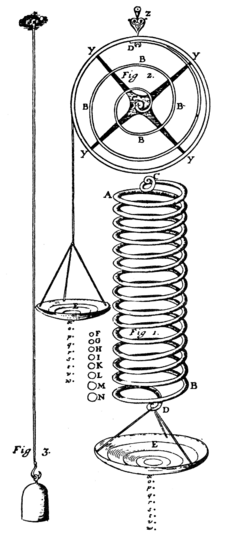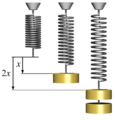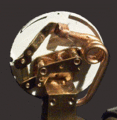Hooke's law facts for kids


It is a law of mechanics and physics discovered by Robert Hooke.
This theory of elasticity says the extension of a spring is proportional to the load applied to it. Many materials obey this law as long as the load does not exceed the material's elastic limit. Materials for which Hooke's law is useful are known as linear-elastic or "Hookean" materials.
The spring equation
The length of a spring always changes by the same amount when it is pushed or pulled. The equation for this is:

- where
- F is how much (push or pull) is on the spring
- k is a constant, the stiffness of the spring.
- x is how far the spring was pushed or pulled
When x = 0, the spring is at the equilibrium position. This equation only works on a linear spring. A linear spring is a spring that is only being pushed or pulled in one direction, such as left or right or up or down.
Elastic potential energy
Examples of everyday objects that have elastic potential energy are stretched or compressed elastic bands, springs, bungee cords, car shock absorbers, etc.
Elastic potential energy is the energy saved in an object that is stretched, compressed (compression is pressing objects together), twisted or bent. For example, an arrow gets the elastic potential energy from the bow. When it leaves the bow, the potential energy turns into kinetic energy. The equation of the elastic potential energy is:

- Which means:
- U is the elastic potential energy.
- k is the spring constant.
- x is the distance pushed or pulled.
Images for kids
-
Bourdon tubes are based on Hooke's law. The force created by gas pressure inside the coiled metal tube above unwinds it by an amount proportional to the pressure.
-
(a) Schematic of a polymer nanospring. The coil radius, R, pitch, P, length of the spring, L, and the number of turns, N, are 2.5 μm, 2.0 μm, 13 μm, and 4, respectively. Electron micrographs of the nanospring, before loading (b-e), stretched (f), compressed (g), bent (h), and recovered (i). All scale bars are 2 μm. The spring followed a linear response against applied force, demonstrating the validity of Hooke's law at the nanoscale.
See also
 In Spanish: Ley de elasticidad de Hooke para niños
In Spanish: Ley de elasticidad de Hooke para niños






